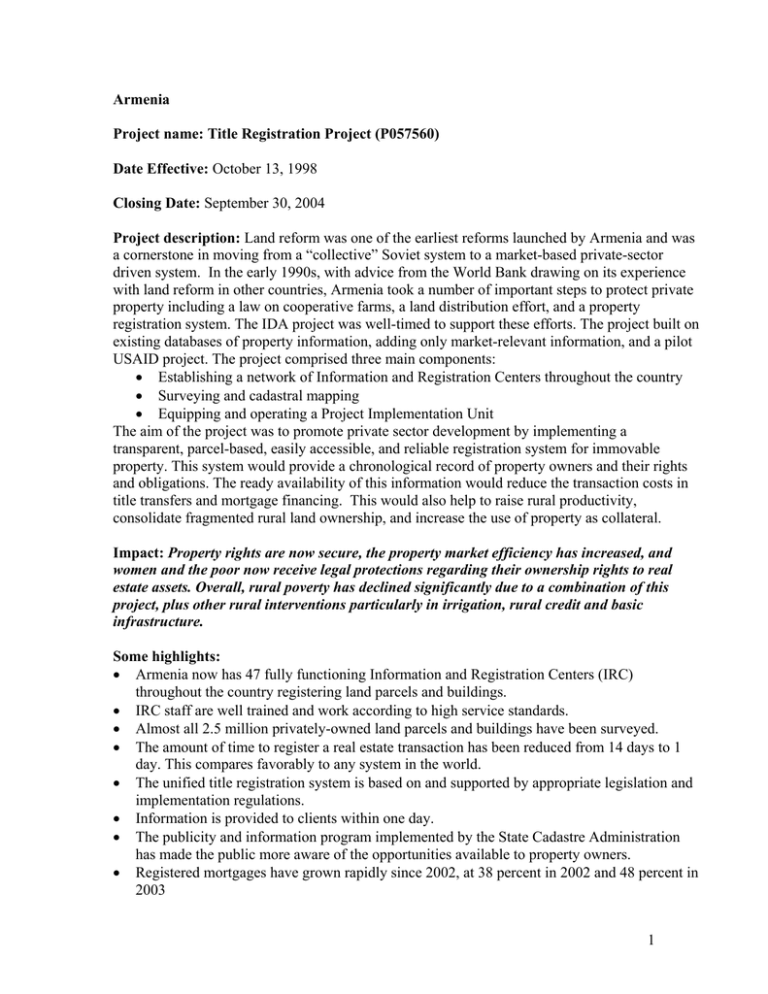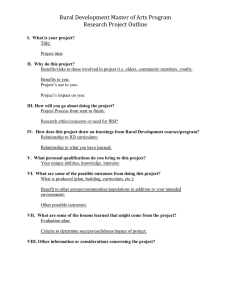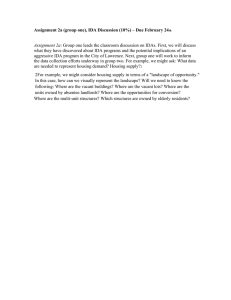1 Armenia Project name: Title Registration Project
advertisement

Armenia Project name: Title Registration Project (P057560) Date Effective: October 13, 1998 Closing Date: September 30, 2004 Project description: Land reform was one of the earliest reforms launched by Armenia and was a cornerstone in moving from a “collective” Soviet system to a market-based private-sector driven system. In the early 1990s, with advice from the World Bank drawing on its experience with land reform in other countries, Armenia took a number of important steps to protect private property including a law on cooperative farms, a land distribution effort, and a property registration system. The IDA project was well-timed to support these efforts. The project built on existing databases of property information, adding only market-relevant information, and a pilot USAID project. The project comprised three main components: • Establishing a network of Information and Registration Centers throughout the country • Surveying and cadastral mapping • Equipping and operating a Project Implementation Unit The aim of the project was to promote private sector development by implementing a transparent, parcel-based, easily accessible, and reliable registration system for immovable property. This system would provide a chronological record of property owners and their rights and obligations. The ready availability of this information would reduce the transaction costs in title transfers and mortgage financing. This would also help to raise rural productivity, consolidate fragmented rural land ownership, and increase the use of property as collateral. Impact: Property rights are now secure, the property market efficiency has increased, and women and the poor now receive legal protections regarding their ownership rights to real estate assets. Overall, rural poverty has declined significantly due to a combination of this project, plus other rural interventions particularly in irrigation, rural credit and basic infrastructure. Some highlights: • Armenia now has 47 fully functioning Information and Registration Centers (IRC) throughout the country registering land parcels and buildings. • IRC staff are well trained and work according to high service standards. • Almost all 2.5 million privately-owned land parcels and buildings have been surveyed. • The amount of time to register a real estate transaction has been reduced from 14 days to 1 day. This compares favorably to any system in the world. • The unified title registration system is based on and supported by appropriate legislation and implementation regulations. • Information is provided to clients within one day. • The publicity and information program implemented by the State Cadastre Administration has made the public more aware of the opportunities available to property owners. • Registered mortgages have grown rapidly since 2002, at 38 percent in 2002 and 48 percent in 2003 1 • Tax equity has significantly improved—nearly all properties are now recorded and municipalities and rural communities can begin to levy property taxes. Total Financing: Total project cost was $10.6 million, of which IDA provided US$8.0 million. Other partners involved in the project include the US, Sweden, and the EU. IDA Contribution: IDA provided the analytic and strategic framework right from the start, drawing on its experience in land privatization in other countries. It also built on earlier work by the Government under a USAID-funded pilot project to ensure a high degree of local ownership and helped scale up a working model. It was also a strong example of donor collaboration: IDA was able to fuse together a strong partnership framework. SIDA financed the upgrading of the geodetic network as well as technical assistance in title registration, and USAID provided most of the early technical assistance in registration. Switzerland financed aerial photography, mapping, and associated technical assistance and training. These donor contributions were folded into the project’s planning, enabling IDA to focus on quality, including a number of new activities designed to improve service efficiency, transparency, client responsiveness, and the purchase of satellite imagery. IDA also capitalized upon other donors’ funding, for instance by focusing its survey activities in urban areas, while the EU addressed rural areas. A Japan Population and Human Resources Development Grant was used to prepare the project and build initial capacity within State Cadastre Administration. Linkages: The project was grounded in the framework of small scale privatization and the establishment of secure property rights supported under first and second Structural Adjustment Credit for Armenia. It was further complemented by other IDA rural interventions including on irrigation and rural credit, and small scale infrastructure supported under the Social Investment Fund. This combination of efforts was able to ensure that growth in the rural areas was able to keep pace with overall country economic growth, and significantly reduce rural poverty. Next Steps: The user fees collected by the State Committee on the Real Property Cadastre (SCRPC) cover the cost of Information and Registration Centers (IRC) operations and maintenance. The system's financial viability is expected to further improve as the volume of transactions continues to increase, while staff costs are expected to decline now that the initial systematic registration effort is completed. The technical and operational aspects of the cadastral information and registration functions and the mapping facility are of high standard. Administrative and technical capacity throughout the entire system is high, and the determined and successful efforts made in recent years to develop a client-oriented, reliable and high-quality service bode well for continually growing user acceptance. 2


